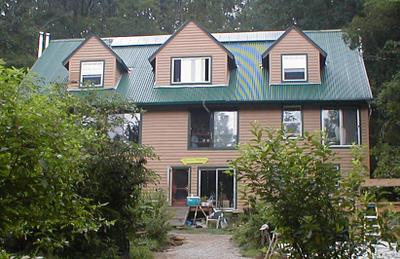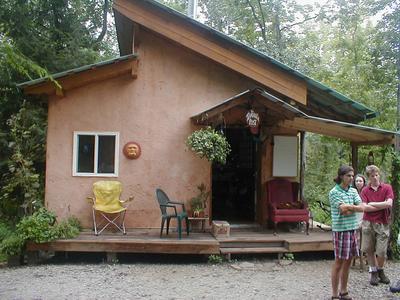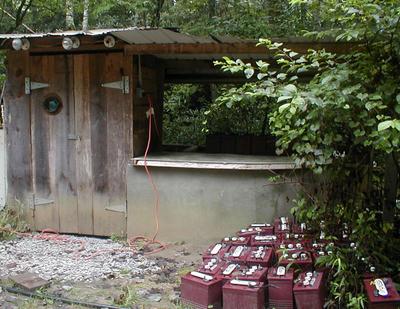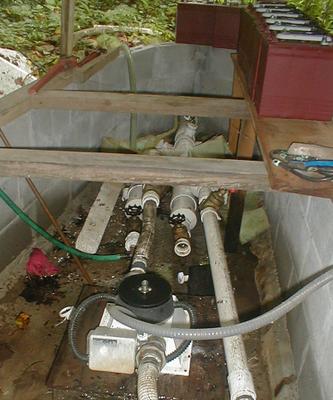
I visited Earthaven Ecovillage on my way home from the Communities Conference.
Founded in 1994, Earthaven is located on 320 acres in culturally rich, biologically diverse western North Carolina, about 40 minutes southeast of Asheville. We are dedicated to caring for people and the Earth by learning and demonstrating a holistic, sustainable culture.
 We drove a very winding road up the mountain to the front gate. We were planning on staying in the A & A so followed the signs across three streams (two of them without bridges) to a large three-story building with a big garden in front.
We drove a very winding road up the mountain to the front gate. We were planning on staying in the A & A so followed the signs across three streams (two of them without bridges) to a large three-story building with a big garden in front.
 We were welcomed by the proprietors, sisters Patricia Allison and Mary Armstrong. Their mom and Patricia's son and grandson live there too.
We were welcomed by the proprietors, sisters Patricia Allison and Mary Armstrong. Their mom and Patricia's son and grandson live there too.
 The accommodations were modest, to stay the least. The house was basically unfinished. It was built from recycled shipping crates and the walls were raw wood. The first floor was taken up by seven bedrooms, a kitchen and a big dining room. We got special permission to use the indoor bathroom as there were not many guests that night.
The accommodations were modest, to stay the least. The house was basically unfinished. It was built from recycled shipping crates and the walls were raw wood. The first floor was taken up by seven bedrooms, a kitchen and a big dining room. We got special permission to use the indoor bathroom as there were not many guests that night.
We watched as the group staying there circled for a prayer before their dinner. We had just eaten but we joined them in the dining room for a bit of conversation. Toby asked me "so, what do you do in Atlanta?" and when I replied "I research Peak Oil," everyone's head popped up and they all said "Oh!" It turns out they had a meeting about that the night before. So we had a very interesting conversation. Their big question was whether they should cut down trees to clear fields for agriculture while the still could run big equipment or allow the clearing to occur more "organically" as the homesteads went up.
After dinner we sat in the dining room and I worked on my journal. We talked to community members and guests about The Chalice and the Blade (a book that made a big splash in the feminist community because it claimed that humanity was originally a matriarchal cooperative culture) and listened to another member play the guitar and show his kid how to do a wordgame.
The next morning Patricia led us and a group of young people who had been working on National Forest trails on a tour.

We saw all kinds of homes. The one on the right is straw bale construction. Most of them used passive solar design and keep very warm in the winter. The weather is very variable in this part of North Carolina. It can be 40 degrees one day and 70 degrees the next.

There are between 44 and 56 homesteads on the land. So far they have about 60 adults and 15 children living there. They live in neighborhoods. Patricia said they discovered that when people first escaped from the city they wanted to have all kinds of space around them, but once they had settled in they wanted to be closer to everyone else. They are considering doing away with their outlying neighborhoods altogether.

One of their neighborhoods is a cohousing unit. The land lease is cheaper but there is a charge for the shared facilities.

The Council House is the first community owned building and the only one built so far. Right now it hold offices and the school, but they plan on building separate facilities for those. They have meetings and parties there.

It is a gorgeous space. The ceiling is made from wood from the land. They had a cooperative logging and milling company for a while and many of the home use local building materials.

The floor is from donated granite. Patricia says the scrounge a lot of their materials. They put them together in work parties.

The Trading Post is where the addicts get their cigarettes, beer and chocolate. It is also a gathering place. Next door is the White Owl cafe which has a bar and shows movies every month. Its where I'd be hanging out because they have high speed internet connections.

We loved the creative touches. My friend Fay took most of the photographs in this essay.

The community has vegans, vegetarians and omnivors. One family is leasing a field for a cow. Fay thought the chickens looked very happy.

This is the fireplace for the sauna. Earthaven is off the grid. Building costs need to include a PV system.

This is the hydroelectric plant. It powers the Council building and the on site businesses. They plan to add four more. The batteries in front need to be recycled.

There are several robust streams which can be tapped for hydroelectric power. This one has intake pipes 400 feet upstream. That water comes down into smaller and smaller diameter pipes and finally gets sprayed into turbines that generate the power. Simple but effective.

We enjoyed the tour and learned a lot about Earthaven. For much more information, check out their website.
No comments:
Post a Comment